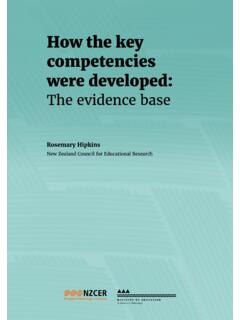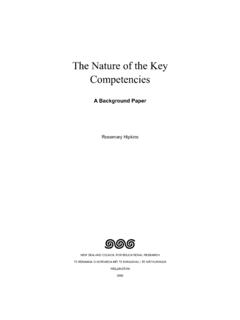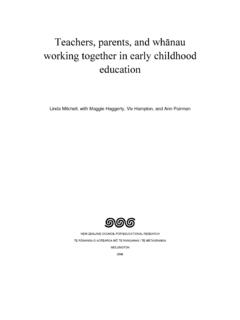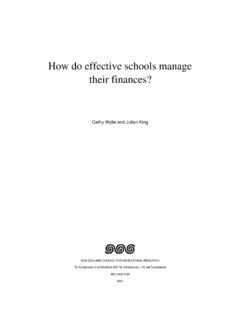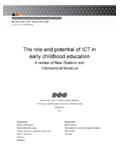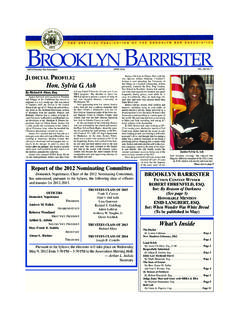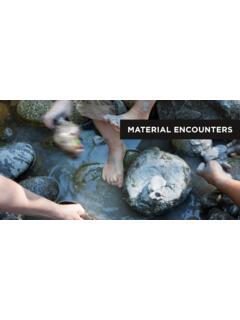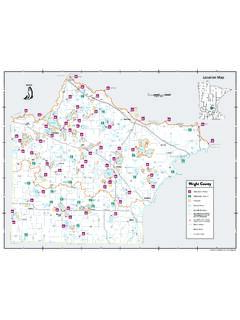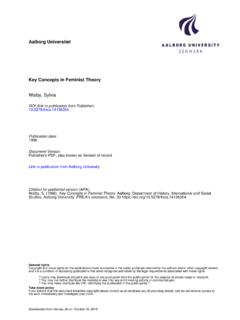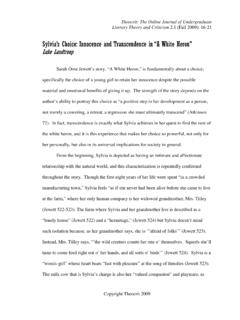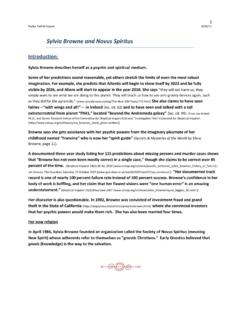Transcription of CHAPTER 1 Introduction: Sylvia, a New Zealander
1 5 sylvia Ashton-Warner had an intensely ambivalent relationship with the land of her birth. Despite receiving many accolades in New Zealand including the country s major literary award1 she claimed to have been rejected and persecuted, and regularly announced that her educational and literary achievements were unappreciated or insuffi ciently acknowledged by her compatriots. In her darkest moments, she railed against New Zealand and New Zealanders, even stating in one television interview: I m not a New Zealander ! 2 This book makes sylvia s relationship with New Zealand its central Her autobiography I Passed This Way won the nonfi ction section of the 1980 New Zealand Book Awards. 2 Jack Shallcrass interviewed sylvia Ashton-Warner on television in 1978.
2 (Barnett, 1978). CHAPTER 1 Introduction: sylvia , a New ZealanderAlison Jones and Sue Middleton16 Today, sylvia Ashton-Warner s 11 books the last of which was published in 1986 are all out of print. When they appeared at the end of the 1950s, her novels Spinster and Incense to Idols made Time magazine s best books lists; in 1963 her teaching scheme, Teacher, was favourably reviewed on the front page of the New York Times Book Review. But by 2002, C. K. Stead, a leading fi gure in New Zealand literature, could see no sign in academic or literary circles of serious interest in her work a fact all the more puzzling when considered against the background of 1980s feminism and the determined search in universities for neglected women writers (2002, p.)
3 4). Similarly, New Zealand educationist Alison Jones found that in 2006 amongst dozens of teacher-trainees, teachers, and teacher-educators in Auckland, most had only a vague idea of who [ sylvia ] was (2006, p. 15). One of our aims in this book is to introduce sylvia Ashton-Warner s work to a new generation of readers in literature and education. For those unfamiliar with sylvia Ashton-Warner s life, we have provided below a short biographical narrative as a guide to the events and places mentioned in this book s chapters originated as research papers, memoirs or live interviews presented at the International sylvia Ashton-Warner Centennial Conference an event held in August 2008 at The University of Auckland s Faculty of Education to mark the centenary of Ashton-Warner s birth.
4 The conference attracted literary scholars, artists, schoolteachers, academic educationists, and biographers from the USA and Australia as well as New Zealand. As with sylvia s own writing, the conference crossed genre boundaries between the literary and the pedagogical, and between fi ction, biography and Ashton-Warner s refusal to fit any one category may provide a clue to the surprisingly low visibility of her work: It falls between disciplines. Journal articles, reviews and book chapters 7produced in specialised fi elds have treated her writing as either educational or literary, not as both. But her work itself always defi ed such simple categorisation: her fi ction was autobiographical and her autobiographies were often fi ctional.
5 Her educational theory was expressed in the form of novels (Spinster; Bell Call) or as autobiography (Teacher; Spearpoint). Her noneducational novels (Greenstone; Incense to Idols; and Three) are largely unknown to an education audience, yet these also include elements of her educational thinking. Lynley Hood s award-winning 1988 biography, sylvia ! The Biography of sylvia Ashton-Warner, meticulously traces her life and her complex personality, but it does not interrogate sylvia s educational or literary contributions, or the relations between the two. So a second objective of this book, and of the conference in which it originated, is to pull together some of the strands of sylvia Ashton-Warner s writing by examining it within the context of its production.
6 Other worksPortrayals of sylvia Ashton-Warner s life are scattered through visual and print Her life has been the subject of New Zealand radio and television interviews and documentaries, and two fi ctionalised fi Her own self-portrayals are in two autobiographies (Myself, 1967, and I Passed This Way, fi rst published in 1979 by Knopf), as well as being woven into all her novels. Lynley Hood s excellent biography retraced the convoluted paths of sylvia s autobiographical narratives, interrogated their historical accuracy, speculated on their psychological underpinnings and reviewed her work s reception. 3 The best source of references to textual portrayals of sylvia s life is in Hood (1988, p.)
7 256 258). Television programmes include Three New Zealanders: sylvia Ashton-Warner (Barnett, 1978) (a copy is held by the New Zealand Film Archive) and an interview on Kaleidoscope (Interview, 1980).4 One fi lm was Two Loves (Walter & Maddow, 1961), based on her fi rst novel Spinster, and starring Shirley MacLaine. The other was the 1985 New Zealand-produced sylvia (Firth & Fairfax) based on her autobiographical also published a personal account of her research process, Who is sylvia ? The Diary of a Biography (1990).Aside from biography and autobiography, only two full-length books have been written about sylvia Ashton-Warner: both from an educational perspective, and both from outside New Zealand.
8 Sydney Gurewitz Clemens 1996 book, Pay Attention to the Children: Lessons for Teachers and Parents from sylvia Ashton-Warner is an American handbook for A 2006 collection is Provocations: sylvia Ashton-Warner and Excitability in Education edited by a Canadian (Judith Robertson) and an Australian (Cathryn McConaghy). Three chapters in that collection focus explicitly on Ashton-Warner s New Zealand context: Sue Middleton places Ashton-Warner s theoretical writing on education in wider sites of educational writing and publishing in New Zealand; Alison Jones explores the philosophy and practice of her pedagogy which, considered in the light of today s social anxieties in New Zealand about children, make Ashton-Warner s teaching methods both compelling and dangerous for contemporary educators; and Tess Moeke-Maxwell offers a reading of the biracial character Huia in Ashton-Warner s novel, Greenstone.
9 While Pay Attention was a practical guide, aimed at American classroom teachers, Provocations was more theoretical, for academic readers. In their introduction to Provocations, McConaghy and Robertson (2006) noted a shift in focus from subject to theory in studies of Ashton-Warner. sylvia herself rejected classifi cation as teacher or theorist. Describing herself as an artist rather than a teacher, she claimed to read nothing on teaching or education and expressed a dislike of academic educational theory s unintelligible multisyllabic jargon (1979/1980, p. 471). Refusing to acknowledge other educationists contributions to her ideas, she claimed 5 Clemens provided for the conference a DVD of her lecture entitled sylvia Ashton-Warner goes to Reggio Emilia.
10 9intellectual autonomy: I am my own university, I my own Professor [sic] (1979/1980, p. 354). McConaghy and Robertson s text focused on what they termed the psychic rather than on the historical and sociospatial conditions (2006, p. 5) informing sylvia s work and commentaries on it. sylvia s sociospatial conditions have long bewildered foreign commentators who, from a distance, allow themselves to see sylvia s New Zealand as suffocating. American teacher Sydney Gurewitz Clemens wrote (1996, p. 23): Astonishingly, it was in conventional, dutiful New Zealand that sylvia Ashton-Warner began a lifelong habit of listening to her inner voice, embarking on the journey toward abundant life in 1940! Similarly, speaking from France, another critic argued: In the fi fties her ideas were revolutionary.
